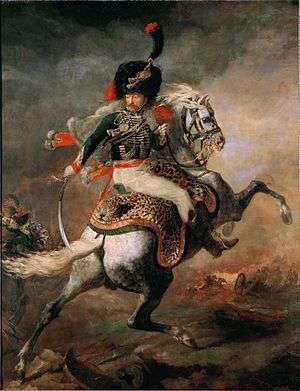The Charging Chasseur
The Charging Chasseur, or An Officer of the Imperial Horse Guards Charging is an oil painting on canvas of about 1812 by the French painter Théodore Géricault, portraying a mounted Napoleonic cavalry officer who is ready to attack.
| The Charging Chasseur | |
|---|---|
 | |
| Artist | Théodore Géricault |
| Year | circa 1812 |
| Medium | Oil on canvas |
| Dimensions | 349 cm × 266 cm (137 in × 105 in) |
| Location | Louvre, Paris |
The painting was Géricault's first exhibited work and it is an example of Géricault's attempt to condense both movement and structure in its art.[1] it represents French romanticism and has a motif similar to Jacques-Louis David's Napoleon Crossing the Alps, but non-classical characteristics of the picture include its dramatic diagonal arrangement and vigorous paint handling.
In The Charging Chasseur, the horse appears to be rearing away from an unseen attacker. The turning figure on a rearing horse is derived from the large early Rubens Saint George (Museo del Prado, 1605–07), though there the view is from the side.
Géricault would continue to move away from classicism, as exemplified in his later masterpiece The Raft of the Medusa (1818–19).
References
- Corso di pittura (in Italian). 3. De Agostini. 1992. p. 21.
Sources
- Chu, Petra ten-Doesschate. Nineteenth Century European Art. Prentice Hall: Upper Saddle River, NJ: 2006.
| Paintings |
|
|---|---|
| Authority control |
|---|